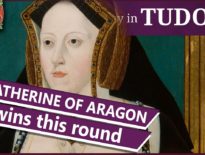On this day in Tudor history, 9th October 1547, Miguel de Cervantes, author of the famous classic “Don Quixote”, a book known as "the first modern novel", was baptised in Alcalá de Henares, Spain. His actual birthdate is unknown.
Now, this event didn’t happen in Tudor England, but it did happen in the Tudor period, and Cervantes is known the world over. Let me share with you some facts about this man, his rather interesting life, which including being held to ransom by pirates, and his works.
Also on this day in history, 9th October 1514, eighteen-year-old Mary Tudor, sister of Henry VIII and daughter of the late Henry VII, married fifty-two year-old King Louis XII of France at Abbeville in France. Find out about her lavish entry into Abbeville and the wedding, including descriptions of Mary and her apparel, in last year’s video:
Also on this day in history:
- 1529 – A writ of praemunire was filed against Cardinal Thomas Wolsey in the court of King’s Bench.
- 1536 – Pilgrimage of Grace: The rebels of Horncastle, Lincoln, dispatched their petition of grievances to the King and also north into Yorkshire.
- 1573 – Death of Sir Thomas Wroth, courtier, politician and landowner. Wroth served Edward VI as a Gentleman of the Privy Chamber and was with him when he died.
- 1604 – Death of Sir William Peryam, Judge, at Little Fulford, near Credington in Devon. He was laid to rest at Holy Cross Church. Peryam was on the commissions at the trials of Mary, Queen of Scots, the Earl of Arundel, the Earl of Essex and Sir John Perrot, and served as Chief Baron of the Exchequer from 1593 until his death.
Transcript:
On this day in Tudor history, 9th October 1547, Miguel de Cervantes, author of the famous classic “Don Quixote”, was baptised in Alcalá de Henares, Spain. His actual birthdate is unknown.
Now, this event didn’t happen in Tudor England, but it did happen in the Tudor period, and Cervantes is known the world over. Let me share with you some facts about this man.
• Cervantes’ father, Rodrigo de Cervantes, was a barber surgeon from Cordoba, and it is thought that he and his wife Leonor de Cortinas had Jewish origins.
• We don’t know what Cervantes looked like. The famous portrait said to be him has not been authenticated unfortunately.
• When Cervantes was six, his father was imprisoned for a few months for debt, during which time, Cervantes’ mother supported the family.
• The Cervantes family spent time in Seville before moving to Madrid in 1566.
• Cervantes moved to Rome and then to Naples after he was arrested and charged with wounding another man in a duel in Madrid in 1569.
• Although he was suffering with malaria at the time, Cervantes served in the fleet Don John of Austria at the Battle of Lepanto in 1571. Although the Ottoman fleet were defeated, Cervantes suffered injuries to his chest and left arm. In his later poetic work Journey to Parnassus, or Viaje del Parnaso, Cervantes wrote of his arm injury, saying that he “lost the movement of the left hand for the glory of the right”.
• In September 1575, the ship on which Cervantes and his brother Rodrigo was serving was captured by Ottoman corsairs and the two men held for ransom. Cervantes’ family could not afford to pay both ransoms and so only paid for Rodrigo. Cervantes was finally set free in 1580 when the Trinitarian Order ransomed him, and he was able to return home to Spain.
• In November 1584, Cervantes’ illegitimate daughter, Isabel was born. Her mother, Ana Franca, was the wife of an inn keeper in Madrid.
• A month later, in December 1584, thirty-seven-year-old Cervantes married Catalina de Salazar y Palacios, who was between 15 and 18 years of age.
• By 1592, Cervantes was a tax collector and actually spent time in prison for “irregularities”.
• In 1613, Cervantes joined The Secular Franciscan Order, an order concerned with helping lay people learn the teachings of St Francis of Assisi, with particular focus on charity.
• Cervantes died on 22nd or 23rd April 1616 and was laid to rest in the Convent of the Barefoot Trinitarians in Madrid.
• His remains were lost during work at the convent in 1673 but found and reburied in 2015.
• Cervantes’ most famous work, “The Ingenious Gentleman Don Quixote of La Mancha”, was published as two volumes in 1605 and 1615, and is known as “the first modern novel”.
• If you haven’t read it, then please do, it’s readily available. The Encyclopaedia Britannic says of it: “Originally conceived as a parody of the chivalric romances that had long been in literary vogue, it describes realistically what befalls an aging knight who, his head bemused by reading such romances, sets out on his old horse Rocinante, with his pragmatic squire, Sancho Panza, to seek adventure. Widely and immediately translated (first English translation 1612), the novel was a great and continuing success and is considered a prototype of the modern novel.”
• Don Quixote has been translated into more than 60 languages.
• Cervantes’ other works include plays, of which only two survive, poems and sonnets, a collection of short stories “Novelas ejemplares”, the pastoral romance La Galatea, and the romance “Los trabajos de Persiles y Sigismunda”.
• If you visit Madrid, you can visit Cervantes’ resting place in the Church of San Ildefonso in the Convent of the Barefoot Trinitarians.



Cevantes was very useful to the Muslim pirates apparently, acting as a translator and currier for them and he posed as a gentleman after his capture. He kept his nails manicured so the Moors thought he was valuable. The pirates would only have kept alive anyone of value or at the very least they would enslave everyone else and sell them into slavery. That was their way. Those of high value, education, good family, gentry, etc or artisans were spared as hostages and worked for the Moors until they were ransomed. A mans hands were studied for signs of work and by having a regular manicure Cervantes was taken for a gentleman.